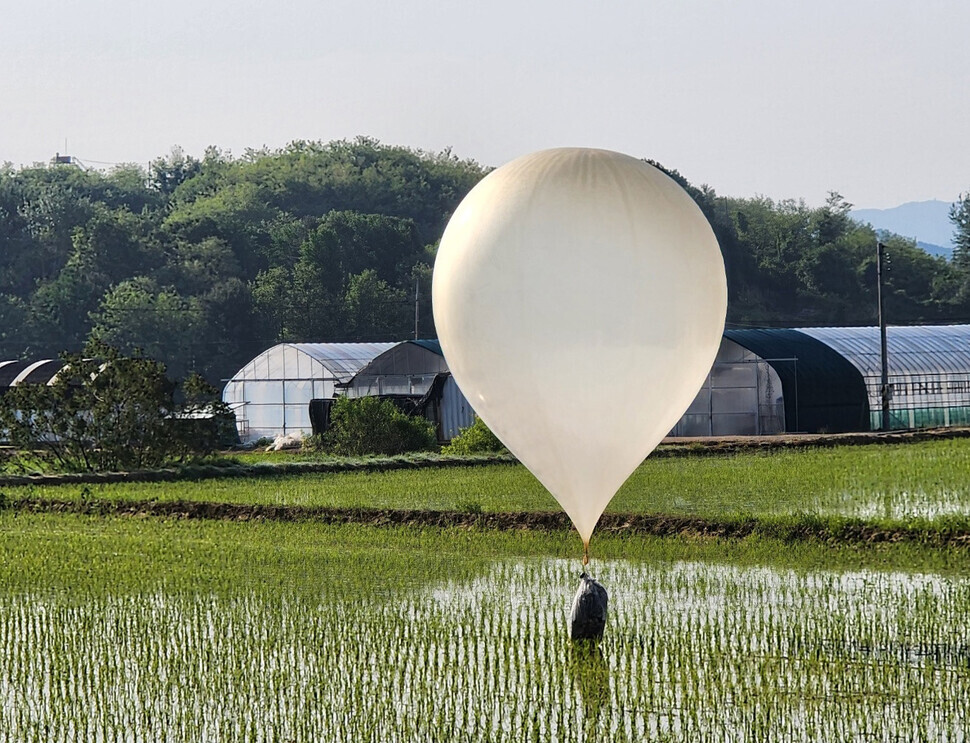hankyoreh
Links to other country sites 다른 나라 사이트 링크
Propaganda leaflets or wastepaper, it’s all still kindling for another Korean war

“The clear waters of the Imjin River / Flow and keep flowing / Birds of all kinds / Fly to and fro as they please.”
The poet Pak Se-yong was born in South Korea’s Gyeonggi Province, but later migrated to North Korea. The lines above are from his poem “Imjin River,” which depicts his longing for the family and friends he left behind in the South. In 1957, the composer Ko Jong-hwan set the piece to music. The scene is simple but telling: A river flows across the border as it likes, just as the birds fly over it without a second thought. Only humans aren’t allowed to cross. Confined by their own boundaries, they are unable to go home.
As tragic as Park’s poem was, it turns out it depicted the good times. Human borders haven’t gotten so razor-sharp since then that they threaten our very existence. South and North Korea continue to send their balloons, full of propaganda and hate, across the Armistice Line. The threat of missiles and nuclear weapons always looms.
Collapse of joint statements and cooperation
According to the South Korean Joint Chiefs of Staff, North Korea launched a series of “waste balloons” across the Armistice Line into South Korean territory, including the Gyeonggi and Gangwon provinces. The balloons even made their way into the greater Seoul area, South Chungcheong Province, and South Gyeongsang Province. Over 260 balloons were uncovered after the first launch. The bags they carried were filled with an assortment of cigarette buts, compost manure, used batteries and various rubbish.
North Korean Vice Defense Minister Kim Kang-il announced the balloon launches on May 26, declaring that “[m]ounds of wastepaper and filth” would soon be launched into South Korea’s border area and heartland. Kim referred to these launches as “tit-for-tat action” in response to launches of anti-North propaganda across the border by South Korean groups. Kim Yo-jong, the sister of state leader Kim Jong-un, also declared, “We make it clear that we will respond to the ROK clans on case-to-case basis by scattering rubbish dozens of times more than those being scattered to us, in the future.”
Yet Fighters for a Free North Korea, the activist group mainly responsible for launching the anti-North content across the border, announced that they only sent 20 balloons, filled with around 300,000 leaflets in total, toward the North on May 10.
While all official inter-Korean military communication lines have been cut off, the only inter-Korean communication that is happening is in the form of balloons carrying leaflets and waste. This indicates the seriousness of the situation. The objective of the balloons isn’t dialogue; their only intention is unilateral criticism, no respect or courtesy involved.
Inter-Korean relations are in critical condition, with insults and abuse being the only form of communication. Anybody who’s ever been in an argument knows: Once you make an accusation, the other side responds with its own. Words become less filtered, and the rage builds up on both sides, elevating the risk of physical violence. We are currently at the point in the conversation where one side is just a second away from raising his hand in violence.
In December 1991, the two Koreas signed the Agreement on Reconciliation, Nonaggression, and Exchanges and Cooperation between the South and North, also known as the Inter-Korean Basic Agreement. This document included an agreement to refrain from attempts to “slander or vilify” the other side. A joint statement adopted on July 4, 1972, contained a similar pact to refrain from insults and abusive language. And now it’s all falling apart.
The biggest issue is the message that North Korea wishes to convey through its recent balloon launches. In the aforementioned warning about the balloons, the North Korean vice defense minister also gave a warning about military measures. Kim claimed that the South Korean Navy and Coast Guard “are frequently crossing our maritime border,” adding, “We officially warn that we can never tolerate such continued encroachment on our maritime sovereignty and that we may exercise our self-defensive power on or under the water at any moment.”
While North Korea has surely given its fair share of warnings in the past, the declaration of an “official warning” sets this message apart. By its threat “official,” Pyongyang has put itself in a bind by obliging itself to live up to its threats when another “intrusion” occurs.

Repetitions of “swift, forceful, definitive”
Kim also made sure to let the South that the “official warning” wasn’t personal but came from above.
“The supreme military leadership of the DPRK on May 24 instructed its army to take offensive action against the enemy’s provocative encroachment upon the sovereignty of the DPRK,” Kim wrote.
Kim was referring to a meeting of the Politburo of the Central Committee of the Workers' Party of Korea.
The Korean Central News Agency reported that the Politburo “heard a general report of the General Staff of the Korean People's Army on the recent military situation,” adding that “the meeting advanced the immediate tasks for military activities by the armed forces of the Democratic People's Republic of Korea to credibly defend the national sovereignty, security and interests, and underlined the need to responsibly carry them out.”
In other words, the country’s military leadership had already made a political decision to “responsibly carry” out military activity, and the North Korean Defense Ministry is merely acting on orders.
The “maritime borders” Kim referred to seemed to be an allusion to Kim Jong-un’s statements on Feb. 14. At the time, Kim Jong-un referred to bolstering military preparedness in the waters north of Yeonpyeong Island and Baengnyeong Island. “It is not important how many lines exist in the West Sea of Korea and there is no need to thrash out the rights and wrongs. What is clear is that when the enemy intrudes into the maritime border recognized by us, we will regard it as an encroachment upon the sovereignty of the DPRK and an armed provocation against it,” he said, according to the KCNA.
Now, Kim Kang-il has “officially” warned of exercises of “self-defensive power.”
Kim Jong-un broke precedent in December of last year by referring to inter-Korean relations as those of “two states hostile to each other.” Since then, North Korea has repeatedly referred to the two Koreas as two separate nations in various political statements. On Jan. 15, North Korea declared that it would not acknowledge the Northern Limit Line (NLL) or any other border it deems “illegal.”
“If the ROK violates even 0.001 mm of our territorial land, air and waters, it will be considered a war provocation,” Pyongyang declared, using the official title of South Korea in an official statement. In mid-January, the North Koreans declared their borders. In February, they announced that they were adopting a defensive military posture, and now they’re officially warning us about military countermeasures.
If the government cared about its people, it would take measures to avoid any conflict related to the “maritime borders” North Korea has mentioned. It would take measures to stop any more unnecessary criticisms going across the border. Yet our president is currently obsessing over hobnobbing and photo ops, while the Defense Ministry keeps shouting about “swift, forceful and definitive” responses like a broken record. They’re dragging their grunts closer toward war.
Where can we find the way to peace? In the 1950s, Pak Se-yong looked at birds flying across the border, dreaming of a day when people could do the same. Now, to even have such dreams seems a lunacy. At least the birds get to fly to and fro as they wish.
By Suh Jae-jung, professor of political science and international relations at the International Christian University in Tokyo
Please direct questions or comments to [english@hani.co.kr]

Editorial・opinion
![[Column] How tragedy pervades weak links in Korean labor [Column] How tragedy pervades weak links in Korean labor](https://flexible.img.hani.co.kr/flexible/normal/500/300/imgdb/original/2024/0703/8717199957128458.jpg) [Column] How tragedy pervades weak links in Korean labor
[Column] How tragedy pervades weak links in Korean labor![[Column] How opposing war became a far-right policy [Column] How opposing war became a far-right policy](https://flexible.img.hani.co.kr/flexible/normal/500/300/imgdb/original/2024/0702/5017199091002075.jpg) [Column] How opposing war became a far-right policy
[Column] How opposing war became a far-right policy- [Editorial] Korea needs to adjust diplomatic course in preparation for a Trump comeback
- [Editorial] Silence won’t save Yoon
- [Column] The miscalculations that started the Korean War mustn’t be repeated
- [Correspondent’s column] China-Europe relations tested once more by EV war
- [Correspondent’s column] Who really created the new ‘axis of evil’?
- [Editorial] Exploiting foreign domestic workers won’t solve Korea’s birth rate problem
- [Column] Kim and Putin’s new world order
- [Editorial] Workplace hazards can be prevented — why weren’t they this time?
Most viewed articles
- 110 days of torture: Korean mental patient’s restraints only removed after death
- 2In the blink of an eye, an unthinkable crash turned a night out into a nightmare
- 3Families, friends mourn loved ones cut down in prime in deadly car crash
- 4Experts cast doubt on driver’s claim that sudden unintended acceleration caused deadly crash
- 5[Column] How tragedy pervades weak links in Korean labor
- 6Democrats seek to impeach 4 prosecutors, including those tied to probes into Lee Jae-myung
- 7KCC chief resigns to avoid impeachment, the second in 7 months
- 8More South Koreans, particularly the young, are leaving their religions
- 9Dreams of a better life brought them to Korea — then a tragic fire tore them apart
- 10Korea to create dedicated population strategy ministry to combat low birth rate, aging society